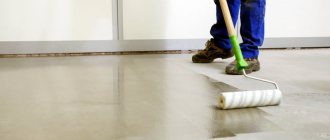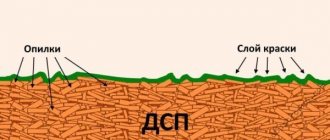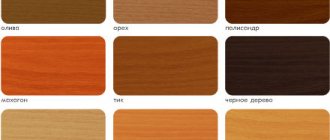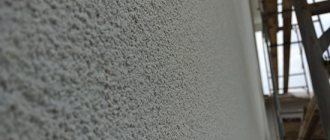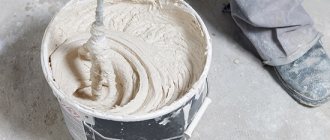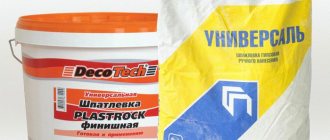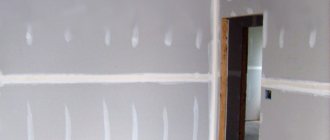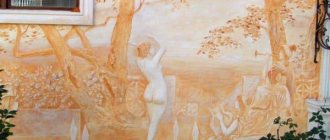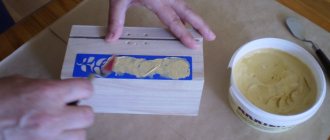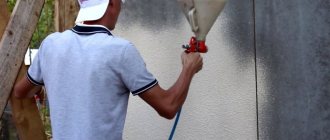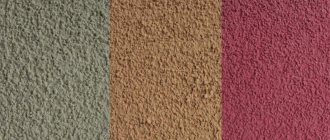An important component of the renovation of premises is smooth surfaces that are subject to finishing, where paint or wallpaper is used. Therefore, the penultimate stage of repair operations is puttying the walls and ceiling. For this, various leveling mixtures based on gypsum or cement are used. This material is easy to apply and inexpensive, but it has one serious drawback - under unfavorable conditions of use, the laid layer may crack. Therefore, manufacturers began to look for a solution to this problem. This is how polymer putty appeared.
Purpose and application
The material is used for a wide variety of work.
Polymer putty is intended for leveling the base (walls, ceilings) before finishing (painting or gluing wallpaper, etc.). Using putty, you can eliminate defects (irregularities, chips, cracks), increase the waterproof characteristics of the surface, the level of sound and heat insulation of the room, etc.
When choosing a material, it is important to consider that such coating is performed for different types of surfaces and operating conditions.
According to purpose, the composition is divided into the following varieties:
- leveling (starting);
- special;
- universal;
- finishing.
Starting putty is used for rough finishing work. The material must be applied in a dense layer to eliminate defects. The composition is dense, holds its shape, does not shrink, and does not spread. After hardening, a durable putty coating is formed. The consumption of these mixtures is high. The composition contains coarse-grained components. The material is selected in accordance with the characteristics of the base, the application layer reaches 3-50 mm.
Finishing polymer putties help eliminate small defects, hide small cracks and form a smooth, even surface. The material is used after the rough coating and is final at the stage of leveling the walls and ceiling.
The universal composition can be used for leveling, eliminating small defects and finishing the panel.
Special putty products contain additional components to solve the required problems. Information about the purpose is indicated by the manufacturer on the label.
Mixtures are produced for finishing fireplaces, stoves with high heat resistance, swimming pools and rooms with high levels of humidity.
Which one to choose, according to what criteria
For the facade it is better to use a cement mixture. But acrylic would also be appropriate here if the wall is under a cornice or canopy.
Cement, latex, and acrylic will work well in wet rooms. You just need to choose according to the degree of wear of the surfaces being repaired. If there are few defects and they are small, then the latex variety is suitable. If there are more flaws, you need to use acrylic.
It is better to finish wooden surfaces with latex. Ceiling and drywall with acrylic.
What is better for finishing walls?
Polymer cement is not suitable for forming the final layer. But other types will do it perfectly. Finishing polymer putty has a fine dispersion of the materials used in them. Its task is to hide small cracks, irregularities and make the surface smooth, intended for final finishing.
Many craftsmen today use universal mixtures. They can be applied in thick or thin layers. But we must pay tribute to specialized solutions. They have better characteristics. That is, for final leveling it is better to use finishing putty.
Composition and technical characteristics, consumption per 1 m2
When producing polymer putty, the composition includes the following components:
- polymers;
- plasticizers;
- chalk;
- hardeners;
- talc;
- acrylic;
- fine-grained fillers;
- coloring pigments, etc.
The composition of different types of mixtures may differ in proportions and ingredients. Manufacturers indicate the parameters on the packaging.
The volume of required material is calculated as follows: the consumption rate of the putty mixture for 1 m² is multiplied by the thickness of the irregularities, the height of the panels and the perimeter of the room. It must be taken into account that manufacturers indicate such parameters according to average standards on the packaging.
Material properties
If we talk about the composition, it includes various plasticizers, antiseptics, binders and hardeners. The connecting link is the polymer component, thanks to which the use of latex putty allows you to protect walls from high humidity due to the formation of an elastic layer, which is durable and easy to process (see also the article “Materials for finishing ceilings - a huge selection for every taste”).
The main advantages can be considered the following factors:
- With this composition you can apply the thinnest layers, even if they are thinner than a millimeter, the coating will be reliable and durable. Therefore, if you are faced with the choice of latex or acrylic putty, and want to cover the walls with the thinnest layer, then the choice is obvious. Acrylic cannot be applied in a thin layer without losing its strength properties.
- Wide choice of colors. You will avoid unnecessary costs, time and money on purchasing paint and coloring, since you can purchase a latex composition of the desired color. In fact, this is a very big advantage that no other type of mixture can provide.
In the photo: this group of materials gives the surface the desired color
The material is very convenient to work with - the mixture is sold ready-made, so it is impossible to make a mistake when diluting and creating the wrong consistency. Simply open the bucket and get to work
The elasticity of the composition simplifies its application, which is very important when doing DIY work
Different packaging of the material will help you purchase the right amount, which will save significant money.
Another very important property is the highest adhesion to almost any substrate. The composition works on the principle of liquid rubber - it fills all cavities and irregularities and adheres tightly to the surface. When hardened, the putty forms a film that does not crack or crumble, which distinguishes it favorably from acrylic and cement compositions
You do not need to be afraid that in places where the layer is thin, cracks will form and the coating will crumble.
This type of product also has some disadvantages, but they are few, which once again indicates high quality:
The biggest drawback is the price. But if you take into account such factors as complete readiness for use immediately after purchase, ease of use even for inexperienced specialists and ready-made color, then it becomes clear that the cost is completely justified. And one more important factor: if the composition freezes during storage, its properties deteriorate significantly.
You are unlikely to be able to work with such a mixture, so it is better to check the production date when purchasing and pay attention to the conditions in which the products are stored; in a cold pavilion, as a rule, such goods deteriorate.
Types of polymer putties for walls
Based on the component, putties are divided into the following subtypes:
- polymer cement;
- latex;
- acrylic.
When purchasing, you need to consider what the finishing mixture is needed for. Putties are divided into materials for interior decoration, facades and universal mixtures. Manufacturers produce dry putty and products in the form of thick ready-made solutions in plastic containers.
Acrylic putties
Acrylic putty mixtures are used for finishing facades and rooms with high humidity levels. The product is moisture resistant, can withstand temperature changes, has good vapor permeability, and is resistant to mold and mildew.
The plasticity of the composition is average; the mass must be stirred regularly before applying to the panels. The material can be tinted in different shades.
Latex putties
Latex putties are made on the basis of rubber resin and have high vapor permeability and strength. However, they are not suitable for finishing rooms with high levels of humidity and facade work. The putty mixture is recommended for renovations in apartments and offices. The material is plastic, easy to apply, does not require complex preparation, and is universal for use by specialists and for independent finishing of premises.
Policeman
Polymer cement putty contains synthetic cement. The material is used as a leveling agent for concrete, cement-lime, brick, cement-sand foundations. The mass has high plasticity and can be applied in layers up to 20 mm. The cement composition is suitable for initial finishing work, treating rooms with high air humidity and facades.
The dense composition allows the mass to be used to eliminate large cracks and depressions in foundations. In some cases, during the initial finishing, the thickness of the layer of polymer-cement putty can reach 30 cm. Large unevenness can be eliminated using this method. Polymer cement is suitable for use with reinforcing mesh and can be applied to the surface in 2 or more coats.
Varieties, what are the composition
It all depends on what polymers were added to the solution. Today, three formulations are popular.
Acrylic
The base is acrylic. This type of material is represented on the market in three positions:
- starting mixture;
- finishing;
- universal.
The last composition is a replacement of the first two. Acrylic putty can be applied up to 4 mm thick. The time after which grinding can be carried out is 6 hours. The finish can be applied only after 24 hours.
Latex
It is based on acrylate latex, also known as styrene. It can be applied even to unprepared wooden surfaces in a layer of no more than 3 mm. Complete hardening time is 24 hours. Sanding can be done after 3 hours. The second layer is applied only after 12 seconds.
Attention! Using latex compounds, you can cover defects with a thickness of no more than 1 mm. And this can be considered a minus.
Polymer-cement
It is clear that this solution is cement based. It is used mainly for leveling facades. But it is also good for wet areas. The main advantage is that the material can be applied in a layer of 2 cm. And the applied layer will not crack over time. In this case, there is no need to use reinforcing mesh.
This is the most durable putty option available on the market. They can repair defects up to 1 cm wide.
Where are polymer putties used?
Polymer putty is used for exterior finishing, decoration of facades, interior spaces, offices, utility units to solve the following problems:
- leveling different types of surfaces (concrete, plaster, wood);
- elimination of cracks and irregularities;
- carrying out reinforcement of the base;
- the product is applied to glass, foam plastic, plasterboard floors, galvanized iron;
- reducing the cost of finishing materials after leveling the layer.
Uneven walls and ceilings
I would like to remind you that in order to smooth out all the unevenness and discrepancies of the ceilings and walls (from 5 to 60 mm), as well as to seal the seams and cracks, we first use plaster.
Leveling walls with plaster
It is this that allows you to obtain a smooth but slightly rough surface. However, ideal surface smoothness can only be achieved by leveling with putty.
Putty is represented on the Russian market by many manufacturers, including the well-known KNAUF, as well as Volma, Saint-Gobain - the brand "weber.vetonit", "Stroymontazh MS", "Starateli" - the brand "Osnovit" , "GK Keraton" - the "Litokol" trademark, "United States Gypsum" - the "Sheetrock" trademark, "Henkel", "Unis" - the "Ceresit" trademark, "Ural Construction Mixes" - the "Bergauf" trademark.
Advantages and disadvantages of polymer putties for interior work
Polymer putty for exterior use has the following advantages:
- the combination of plastic and elastic characteristics of the product allows you to apply the mass in a thin layer;
- the quality characteristics of the material make it possible to use the mixture in the treatment of rough substrates;
- easy application;
- plasticizers and modifiers in the putty provide reliable adhesion to the surface being treated;
- a high-quality applied product does not peel off;
- the absence of shrinkage allows you to accurately calculate the amount of work and prevents cracking of the coating;
- materials are distinguished by water-repellent properties, ensuring their versatility;
- a protective film is formed on the surface of the putty coating;
- the mixture can withstand temperature changes;
- the composition has fire-resistant characteristics and does not melt;
- the material is environmentally friendly, does not contain toxic substances, which means it is safe for indoor use;
- vapor permeability reduces the risk of mold;
- the finished composition retains its technical characteristics for 12 hours in a sealed container;
- Increasing sound and thermal insulation allows you to maintain a stable indoor microclimate.
The list of disadvantages includes the high price of the product.
Which is better - gypsum or polymer mixture?
In the process of interior finishing work, many consumers ask themselves the question: which putty is better - gypsum or polymer? This question does not have a clear answer, because each of these materials has its own pros and cons. And is it possible to compare two completely different mixtures? Most importantly, before making a choice in favor of any of them, you need to take into account the following features of the room being renovated:
- Humidity. If there is high humidity in the room (bathroom, kitchen, veranda), preference should be given to polymer materials. By absorbing moisture, gypsum-based mixtures swell on the walls and begin to fall off.
- Temperature swings. Gypsum mixtures cannot withstand sudden temperature changes, deforming and cracking. Therefore, in this case, you should opt for polymer putty.
- Mechanical influences (vibration). This can lead to the plaster coming off the wall, so again we choose polymer putty.
If the repair is carried out in a dry and warm room, you should pay attention to the gypsum mixture, the difference of which is its affordable price. Remember that high quality material is the key to safety and comfort.
Walls that have been treated with gypsum or polymer mortar acquire a number of positive characteristics:
- do not have a characteristic chemical smell;
- environmentally friendly;
- are not subject to deformation due to the elasticity of the composition;
- fireproof and fire resistant;
- have good sound insulation;
- have protection against fungus and mold.
Thanks to putty, you can level any surface and prepare it for wallpapering or painting. The key to an ideal result is high-quality material and application in compliance with all stages. You just need to carefully study the technology.
Review of the most popular brands - beware of fakes
When purchasing putty mixtures, experts recommend purchasing certified products from trusted brands. These compounds are easy to dilute and the coating will be durable. Products are purchased from branded stores to prevent the purchase of counterfeits.
The rating of putty manufacturers includes the following brands:
- Ceresit;
- Hercules;
- GLIMS;
- Knauf;
- Volma;
- Sheetrock;
- Vetonit;
- Tex;
- Prospectors;
- Scanmix;
- White House;
- Pro;
- Bolars, etc.
Manufacturer
Ceresit
produces a wide range of polymer putty compositions for various purposes. The product line includes putty CT 127 POLYMER PLUS, the material is intended for finishing, the white mass is used for interior finishing. Putty IN 95 is offered in ready-made form, the color of the material is neutral white. The composition of CT 225 is universal and can be used for exterior and interior decoration; the mixture is used to apply the finishing layer.
putty
GLIMS Styro Prime
is universal and intended for starting finishing of bases. The material can be used for rooms with different operating conditions. The coating is resistant to high humidity, temperature changes, and is frost-resistant.
The technical characteristics of the putty mixture allow it to be used for facade and interior decoration.
The mixture is suitable for leveling foundations in swimming pools and bathrooms. The products are certified, environmentally friendly, safe to use, the material is elastic and hardens quickly.
Putty mixture
White House
universal in use for facades and premises. The mass contains acrylic. Domestic products have a high rating among putty products. The material is resistant to high humidity and can be applied in a dense layer. After drying, a white, smooth coating is formed, suitable for subsequent finishing work.
putty
Sheetrock SuperFinish
Designed for finishing work, characterized by high adhesion and no shrinkage. The material has increased strength, is flexible, easy to apply, and dries in 5 hours. Wallpaper can be pasted onto the treated surface, decorative plaster can be applied, and painting can be done.
putty
KNAUF Polymer finish
intended for the final stage of leveling. The white dry mixture is made on the basis of polymer components, has increased adhesion, is resistant to cracking, and is plastic. The material can be used to level the surface with a layer of 0.5-4 mm. Microfibers contained in the mass prevent shrinkage.
After dilution with water, the mixture retains its technical properties for about 72 hours. The composition is suitable for interior finishing of plasterboard, concrete, gypsum fiber, gypsum, cement bases before applying decorative plaster or wallpapering. After hardening, the coating can be easily sanded. The material is applied only by hand. The optimal coating thickness is 4 mm.
The mixture consumption per 1 m² with a layer of 1 mm reaches 1.2 kg, 10 mm - 12 kg. The composition is intended for rooms in which the temperature is kept within +10…+30°C.
Advantages
Modern polymer putties have many advantages. Unlike materials whose main component is cement, polymer mixtures are not subject to deformation and shrinkage over time. They also do not form cracks and do not change their appearance.
Despite the synthetic nature of these materials, they are characterized by such an important property as vapor permeability. This provides a good microclimate in those rooms in which the walls are finished with polymer putty.
- It is noteworthy that these are very durable materials. Thanks to this, polymer putty coatings are resistant to high mechanical loads.
- However, at the same time, these materials have such a characteristic of polymer putties as good ductility, which makes them universal.
- This property allows the material to be easily distributed over the leveled surface without much effort from the master.
- When working with polymer putty, unsightly smudges do not form on the walls, and the material itself dries very quickly.
Polymer mixtures, unlike cement mortars, are very convenient to work with. Even when opened, such putties completely retain their consistency and do not lose their elastic properties.
For twelve hours, the master can not worry about the safety of the finishing material, and, if necessary, at any time have the composition on hand to trim or correct something.
Tips and recommendations for the use of polymer-based starting and finishing putties
When using starting and finishing materials, it is recommended to take into account the requirements specified in the instructions:
- Before applying the putty mixture, the surface must be prepared by cleaning it from old finishing materials, greasy stains, dust and dirt.
- Before the polymer mixture, work areas are treated with a mineral primer.
- To mix the solution, you need to pour the dry powder into a container of water and mix it using an electric drill with an attachment or manually. The solution should sit for 10 minutes and the mixture should be stirred before application. The composition of the required consistency does not flow from the spatula.
- When choosing a starting mixture for finishing wooden bases, it is recommended to choose an acrylic material with a wood structure.
- For facade putty, the frost resistance indicator is important, which is indicated on the packaging and selected in accordance with the climatic conditions of the region.
Dry and ready-made mixtures
On sale you can find dry and liquid polymer-based putties. The second differs in that it can be immediately used for application. Most often it looks like paste.
Before use, dry mixtures must be prepared by mixing with water in certain proportions. Preparation must be carried out in clean containers and strictly follow the instructions from the manufacturer. It is advisable to mix using a construction mixer. First, water is poured into the container, then the mixture is poured in, making sure that no lumps form.
Preparation must be carried out in clean containers and strictly follow the instructions from the manufacturer.
Procedure for applying polymer putty
A type of putty is applied taking into account the following recommendations:
- The surface is pre-treated with a primer mixture.
- The working solution or the finished composition is applied in a thin layer of 3 mm using a spatula.
- After drying, you can apply a second layer and also dry the base.
- When applying the finishing coat, after a few hours the dried surface is sanded with sandpaper or a special grater to smooth the base.
Putty technology
In order for the service life of the finish to correspond to that declared by the manufacturer, the sequence and technology of applying the putty must be strictly followed. First, the base is prepared - it is cleaned of dust, dirt, degreased, and stains of fuel oil and petrochemicals are wiped off. If this is not done, the adhesion force of the putty mass to the wall will decrease. Next, apply a layer of primer, without missing the slightest area. After the product has dried, apply another primer coat to enhance adhesion and bind remaining dust.
If the material is sold in dry form, it is diluted with water before use (usually we are talking about acrylic or polymer-cement mixtures). Strictly observe the proportions indicated on the packaging. Add the mixture powder to pre-measured water, and not vice versa, mix the composition with a construction mixer. The water should be clean and at room temperature. The diluted solution is left for 5-10 minutes, then mixed again. If it turns out thick, add water; if it turns out liquid, add a little more dry powder.
Apply the polymer composition with a medium-sized spatula or trowel, and apply it to the main tool with a small spatula. Hold the device at an acute angle to the surface, carefully rub the putty into a layer of the required thickness (usually 2-3 mm). The maximum possible thickness of the layer is clarified in advance by finding it on the packaging of the product.
If it is necessary to make two layers of polymer putty, then allow the first layer to dry completely, then sand it with sandpaper and prime it again. Only then do the second, finishing layer. After about 4-5 hours, it is rubbed with a construction float or a block with the finest sandpaper in a circular motion.
During mashing, maintain the same pressure in all areas. Act carefully so as not to damage the incompletely set layer. Typically, two-layer application is practiced when the surface is prepared for painting. In other cases, one layer of polymer putty is enough.
Consumption per 1 square meter
The approximate consumption is always indicated on the packaging of a specific product. Usually it is 1-1.5 kg/sq.m. m with a layer thickness of 1 mm. To calculate the total flow rate, you need to multiply the flow rate by the planned width of the layer and by the area of the walls (ceiling). From the total area, you must subtract in advance the dimensions of windows, doors and other surfaces that cannot be processed.
Drying time of the material
The drying time for polymer materials is longer than for gypsum compositions. They usually set within 4-5 hours, but undergo final polymerization within 24-48 hours.
How to putty with your own hands correctly
When putting putty, experts recommend performing work taking into account the following:
- The mass is applied to a wide area of the spatula, then the mixture is transferred to the wall at an angle of 30°.
- For convenient puttying, it is better to use a larger tool.
- The layer is distributed evenly.
- Subsequent coatings are applied overlapping.
- Processing of corner areas is carried out with narrow corner spatulas.
Experts recommend diluting the dry mass in small portions for high-quality processing. If stored unsealed, the composition may lose its performance characteristics.
Choosing putty for drywall
The main mistake when choosing building materials used for processing plasterboard materials is that, according to the majority, such work is pointless. During the renovation process, you may find that the wallpaper refuses to come off the walls. This is due to the fact that the gypsum mixture is glued to the paper. Wetting the material will not give any result, since gypsum board is an incredibly soft material, which will leave indentations from the tools used.
To remove seams and other irregularities, it is better to use professional products. This is especially true in cases where the working coating will be painted, but filling the voids alone may not be sufficient. In some cases, you should use reinforcing tape. Before wallpapering, you can only treat the most obvious irregularities, and level the rest with starting plaster. It should be understood that the quality of inexpensive products is questionable, and since repairs are carried out infrequently, you should not save.
Polymer-cement
The role of the binding component in polymer-cement putties, as their name suggests, is played by artificially created cement. It can be used for work both inside and outside the house.
The thickness of the applied layer can reach 3 cm. Thanks to such mixtures, it is possible to hide significant irregularities and cracks.
How to choose a finishing mixture
Before you begin finishing work, you need to choose the ideal mixture. It is necessary to take into account the operating conditions in the room and the type of manipulations performed.
Manufacturers offer a wide range of formulations that have their own individual characteristics. Before starting finishing, the specialist finally inspects the working plane on which the cladding will be done. Finishing putty is suitable for finishing surfaces under:
- wallpapering;
- decorative plaster;
- textile covering.
It will hide small flaws. Some polymer putties have an insulation effect and soundproofing function, but their main purpose is to level the planes for further cladding.
Polymer material is not suitable for leveling surfaces with deep defects. Soil mixtures are intended for these works.
Advantages of polymer-based putty
Polymer-based putty appeared on store shelves relatively recently, but has already become quite widespread.
This is due to the following advantages:
- no shrinkage or deformation;
- increased adhesion;
- good vapor permeability;
- uniform drying;
- ease of application;
- resistance to mechanical stress;
- high quality of the final result.
The only disadvantage of polymer mixtures is their high cost.
Latex
They are compositions based on rubber resins of artificial origin. Positive aspects - good adhesion and vapor permeability, excellent ductility, no shrinkage, high quality coating.
The downside is reduced moisture resistance. These are ideal polymer putties for interior work. It is better not to use them for facades.
Features of choice
When choosing mixtures for leveling, it is worth considering the following points:
- conditions for the location of the surfaces to be treated;
- materials used for subsequent finishing;
- probability of mechanical damage.
If you need material for facade work, it is better to choose an acrylic mixture. It is resistant to moisture and temperature changes, the most durable and durable.
Buy a latex mixture if you need a perfectly smooth and even base for painting or thin wallpaper.
For uneven walls, preference can be given to polymer-cement mixtures, which can be applied in a layer of up to thirty millimeters.
It is better to choose putties from reliable, trusted manufacturers, whose material will last for many years.
I recommend!
In order to save money, use expensive polymer putty for the finishing coating, and cheaper gypsum or cement-based mixtures for initial leveling.
